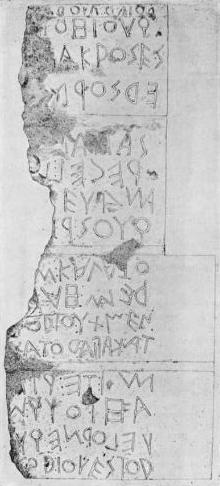Boustrophedon (/ˌbuːstrəˈfiːdən/[1]) is a style of writing in which alternate lines of writing are reversed, with letters also written in reverse, mirror-style. This is in contrast to modern European languages, where lines always begin on the same side, usually the left.
The original term comes from Ancient Greek: βουστροφηδόν, boustrophēdón, a composite of βοῦς, bous, "ox"; στροφή, strophḗ, "turn"; and the adverbial suffix -δόν, -dón, "like, in the manner of" – that is, "like the ox turns [while plowing]".[2] It is mostly seen in ancient manuscripts and other inscriptions. It was a common way of writing on stone in ancient Greece[3] becoming less and less popular throughout the Hellenistic period. Many ancient scripts, such as Etruscan, Safaitic, and Sabaean, were frequently or even typically written boustrophedon.
The Forum inscription (one of the oldest known Latin inscriptions) is written boustrophedon, albeit irregularly: reading from top to bottom, lines 1, 3, 5, 7, 9, 11, 12, 14, 16 run from right to left; lines 2, 4, 6, 8, 10, 13, and 15, from left to right; 8, 9, and 16 are upside down. (From a rubbing by Domenico Comparetti.)

Reverse boustrophedon[edit]
Schematic of reverse boustrophedon text, in the fashion of rongorongo, but using the Latin alphabet

Rongorongo tablet highlighting a few glyphs symmetrical through a 180° rotation (reverse boustrophedon)

The wooden boards and other incised artefacts of Rapa Nui also bear a boustrophedonic script called Rongorongo, which remains undeciphered. In Rongorongo, the text in alternate lines was rotated 180 degrees rather than mirrored; this is termed reverse boustrophedon.[4]